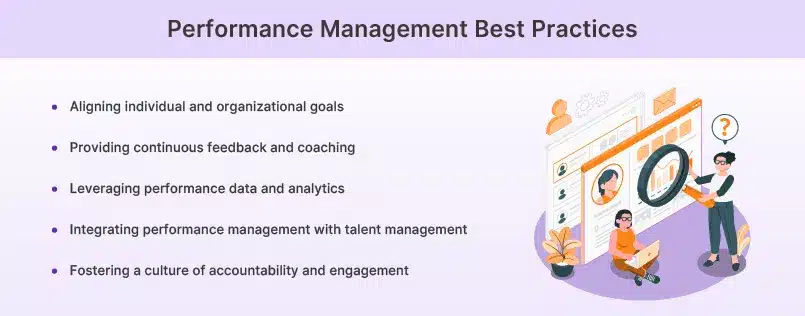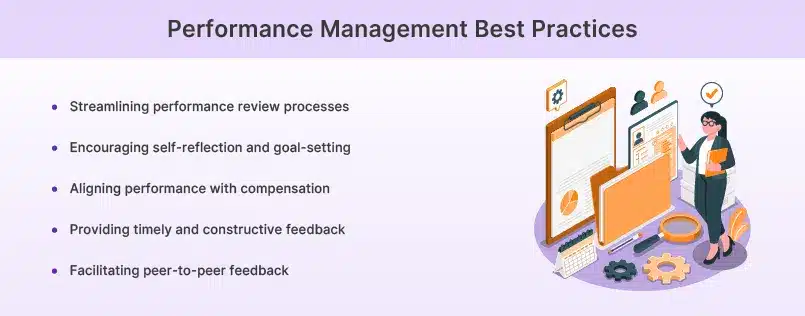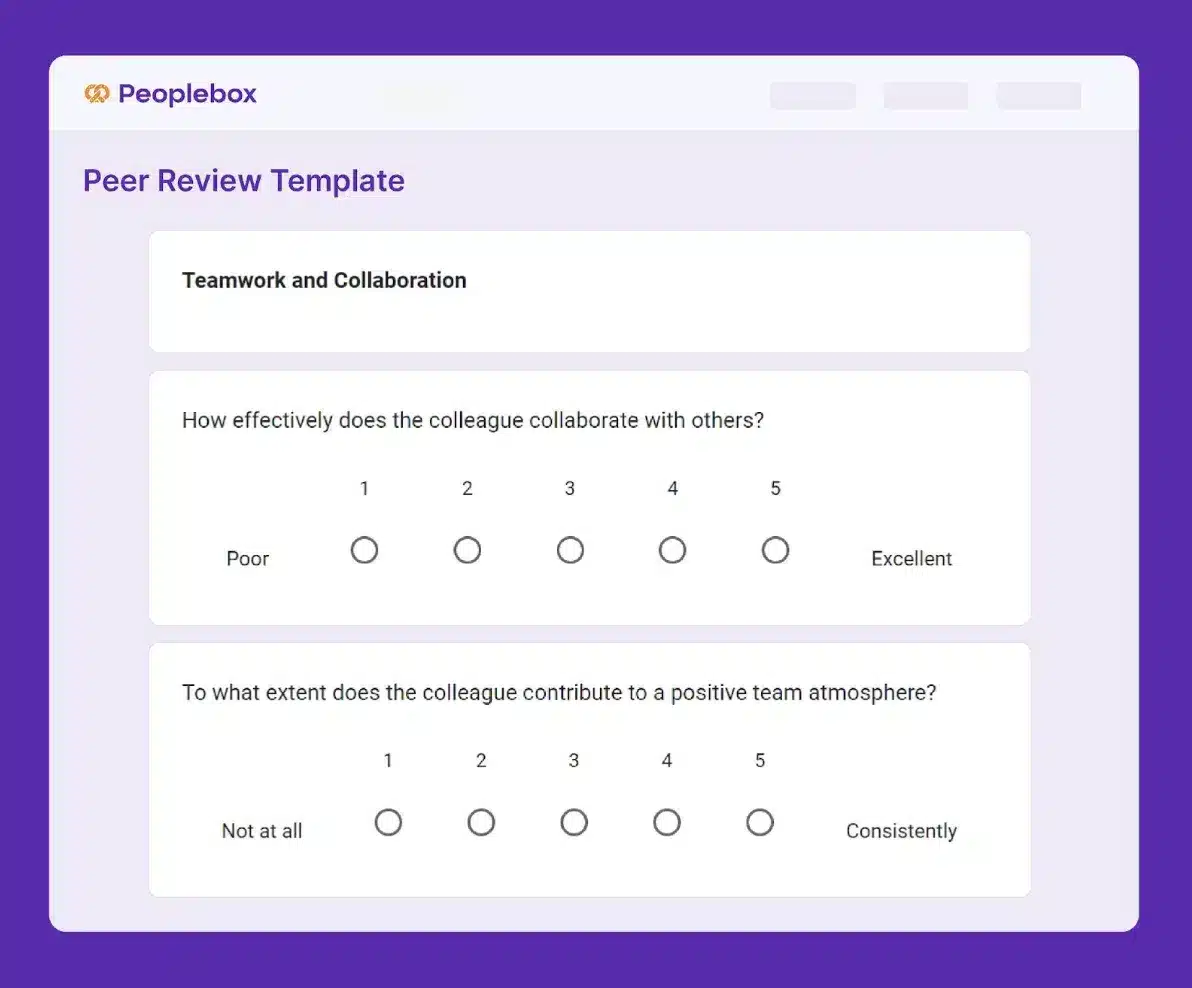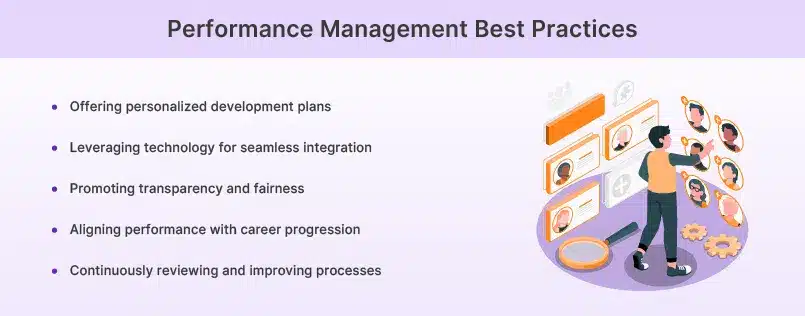Effective performance management is the backbone of a thriving organization. It’s more than just annual reviews and performance appraisals; it’s an ongoing process that helps align individual goals with organizational objectives, fostering a culture of continuous improvement and engagement.
It wouldn’t be wrong to say that adopting the right performance management best practices is crucial for retaining top talent and driving business success.
This blog post will explore the best practices in performance management that enhance organizational effectiveness and empower employees to reach their full potential.

Before we get started, here’s a quick look at the basics.
What is Performance Management?
Performance management is a continuous process that involves setting goals, monitoring progress, providing feedback, and facilitating employee development to enhance individual and organizational performance.
It includes a variety of activities, such as performance appraisals, goal setting, coaching, and feedback, aimed at aligning employee performance with the strategic objectives of the organization.
The ultimate goal of performance management is to improve overall productivity, foster professional growth, and ensure that employees are engaged and motivated to contribute to the organization’s success.
What are the 5 Elements of Performance Management?
The 5 key elements of performance management are:

Goal Setting
Establishing clear and measurable objectives that align with organizational goals. This provides employees with direction and a sense of purpose.
Continuous Feedback
Providing regular, constructive feedback to employees about their performance. This helps employees understand how they are performing and where they can improve.
Performance Appraisal
Conducting formal evaluations of employee performance at regular intervals. This process assesses an employee’s accomplishments and areas for improvement over a specific period.
Development and Training
Identifying areas where employees can grow and providing them with the necessary training and individual development opportunities. This ensures that employees have the skills and knowledge needed to perform their roles effectively.
Recognition and Rewards
Acknowledging and rewarding employees for their achievements and contributions. This can include financial rewards, promotions, or other forms of recognition that motivate and engage employees.
Peoplebox.ai’s Top 15 Performance Management Best Practices
Now that we’ve covered the basics, let’s quickly look at the top 15 performance management best practices you need to implement right away for a fruitful performance review process.

1. Aligning Individual and Organizational Goals
Link individual goals to broader organizational objectives to ensure that employees understand how their work contributes to the company’s success. Goal-setting frameworks like OKRs (Objectives and Key Results) can help in this alignment.
How to Achieve Effective Goal Alignment
- Use Goal-Setting Frameworks: Leverage OKRs (Objectives and Key Results) to create clear, measurable, and achievable goals that align with business priorities.
- Quarterly Goal-Setting Sessions: Encourage teams to collaboratively define their objectives in sync with company strategy, ensuring alignment at every level.
- Empower Managers: Provide managers with the right training to facilitate meaningful goal-setting discussions, balancing individual aspirations with organizational priorities.
Benefits of aligning individual and organizational goals
Aligning individual and organizational goals ensures that employees understand the bigger picture and feel a sense of purpose in their work.
It also helps managers allocate resources more effectively and measure the impact of individual contributions on overall company performance.

2. Providing Continuous Feedback and Coaching
Establish a culture of regular check-ins and constructive feedback. This approach fosters an environment where employees feel supported and can continuously improve.
How to Implement Continuous Feedback Effectively
- Schedule Bi-Weekly one-on-one meetings : These sessions provide a dedicated space to discuss progress, challenges, and development opportunities.
- Encourage Balanced Feedback: Train managers to provide both positive reinforcement and constructive feedback, focusing on specific behaviors and measurable outcomes.
- Leverage Proven Feedback Techniques: Use methods like the “sandwich” approach start with positive feedback, provide constructive criticism, and end with encouragement to keep feedback both actionable and motivating.
Benefits of providing continuous feedback
Continuous feedback and coaching enable employees to course-correct quickly, identify areas for improvement, and feel valued for their contributions. It also helps managers identify high-potential employees and provide targeted development opportunities.
3. Leveraging Performance Data and Analytics
Utilize data-driven insights to identify high-potential employees, predict turnover, and optimize training programs. This analytical approach can enhance decision-making and resource allocation.
How to Effectively Use Performance Data
- Implement performance management software to track key metrics, monitor employee progress, and generate real-time reports on performance trends.
- Collaborate with Data Analysts to identify meaningful patterns, refine evaluation processes, and create custom dashboards that transform raw data into actionable insights.
- Use Predictive Analytics to forecast turnover risks, pinpoint skill gaps, and optimize training initiatives for long-term workforce success.
Benefits of leveraging performance data
Performance data and analytics provide an objective basis for decision-making, helping organizations make informed choices about talent management, training, and resource allocation. It also enables companies to identify areas for improvement and measure the impact of their performance management initiatives.
4. Integrating Performance Management with Talent Management
Connect performance data to decisions around compensation, succession planning, and career development. This integration ensures that talent management strategies are informed by performance insights.
How to Effectively Integrate Performance and Talent Management
- Leverage performance reviews to identify high-potential employees and tailor leadership development programs that prepare them for future roles.
- Align Performance Data with Compensation & Promotions by working with HR to create a transparent framework that connects employee achievements to rewards and career growth.
- Develop Personalized Career Paths based on performance trends, ensuring employees have clear opportunities for skill-building and advancement.
Benefits of integrating performance management with talent management
Integrating performance management with talent management creates a holistic approach to employee development and succession planning. It ensures that high-performing employees are recognized and rewarded, while also providing a clear path for career advancement.

5. Fostering a Culture of Accountability and Engagement
Encourage employees to take ownership of their performance and promote a collaborative work environment. This accountability can drive engagement and motivation.
How to Foster Accountability and Engagement
- Create Team Accountability Groups where employees regularly check in on progress, support each other, and stay committed to shared goals.
- Provide Training on Goal-Setting and Time Management to help employees develop skills that enhance productivity and self-discipline.
- Encourage Transparent Communication by establishing regular forums where employees can share challenges, progress, and ideas for improvement.
Benefits of fostering a culture of accountability
A culture of accountability and engagement empowers employees to take control of their performance and development. It also promotes collaboration, teamwork, and a sense of shared purpose, leading to higher levels of motivation and job satisfaction.

6. Streamlining Performance Review Processes
Implement customizable templates and automate administrative tasks to simplify the performance review process. This streamlining can reduce the burden on managers and improve the review experience for employees.
How to Streamline Performance Reviews
- Use a Performance Management Platform that enables easy customization of review forms tailored to different roles and objectives.
- Automate Reminders and Follow-Ups to ensure timely completion of reviews and keep managers on track throughout the year.
- Encourage Ongoing Performance Tracking instead of relying solely on annual evaluations, fostering a culture of continuous feedback and improvement.
Benefits of streamlining performance reviews
Streamlining the performance review process saves time for both managers and employees, allowing for more meaningful discussions during reviews. It also ensures that performance evaluations are based on consistent criteria, leading to fairer assessments..

7. Encouraging Self-Reflection and Goal-Setting
Encourage self-reflection and personal goal-setting to empower employees to take an active role in performance management. This practice promotes ownership and self-awareness.
How to Encourage Self-Reflection and Goal-Setting
- Provide Goal-Tracking Tools to help employees monitor their progress and make necessary adjustments.
- Encourage OKRs (Objectives & Key Results) that align with both personal aspirations and organizational objectives.
- Create a Culture of Self-Evaluation by integrating reflection exercises into regular performance discussions.
Benefits of self-evaluation
Encouraging self-evaluation and goal-setting fosters a growth mindset among employees, helping them take ownership of their development. It also enhances motivation and engagement, as employees see their progress and achievements over time.
8. Aligning Performance with Compensation and Rewards
Link employee performance to fair and transparent compensation and recognition programs. This alignment ensures that employees feel valued for their contributions and are motivated to perform at their best.
How to Align Performance with Compensation & Rewards
- Develop a Clear Performance-Based Bonus Structure that is transparent and consistently applied.
- Tie Rewards to Measurable Outcomes to ensure fairness and eliminate bias.
- Communicate Compensation Criteria Effectively so employees understand how their performance impacts rewards.
Benefits of pay for performance
Aligning performance with compensation and rewards creates a culture of meritocracy where employees feel recognized for their hard work. This practice can lead to increased motivation, job satisfaction, and retention rates.

9. Providing Timely and Constructive Feedback
Ensure that feedback is specific, actionable, and delivered promptly. Timely feedback helps employees make necessary adjustments and fosters continuous improvement.
How to Provide Effective Feedback
- Train Managers on Clear & Constructive Feedback Techniques to ensure feedback is balanced and growth-oriented.
- Deliver Feedback as Close to the Event as Possible to maximize impact and relevance.
- Encourage Ongoing Conversations rather than relying solely on formal review periods.
Benefits of constructive criticism
Timely and constructive feedback helps employees understand their performance in real-time, enabling them to make adjustments and improve. It also fosters a culture of open communication and continuous learning.

10. Facilitating Peer-to-Peer Feedback
Encourage employees to provide feedback to their colleagues, fostering a culture of mutual support and collaboration. Peer feedback can enhance team dynamics and performance.
How to Facilitate Effective Peer Feedback
- Implement a peer review system where employees can regularly give and receive feedback.
- Provide Clear Guidelines on delivering constructive feedback to ensure it’s productive and respectful.
- Create a Safe Environment where open and honest feedback can thrive without fear of retaliation.
Benefits of peer reviews
Facilitating peer-to-peer feedback encourages collaboration and strengthens relationships among team members. It also helps employees gain diverse perspectives on their performance and fosters a culture of continuous improvement.
Looking for ways to improve your peer feedback process? Download our free peer review template today!


11. Offering Personalized Development Plans
Create tailored learning and development plans based on individual strengths and weaknesses. Personalized plans can significantly enhance employee engagement and skill development.
How to Create Personalized Development Plans
- Conduct Assessments to identify each employee’s strengths and areas for improvement.
- Collaborate on a Development Plan that includes formal training, mentorship, and on-the-job learning experiences.
- Set Clear Milestones to track progress and adjust plans as needed.
Benefits of Individual Development Plans
Offering personalized development plans demonstrates a commitment to employee growth and development. It increases engagement and retention by showing employees that the organization values their career aspirations and is willing to invest in their future.
12. Leveraging Technology for Seamless Integration

Integrate performance management tools with existing workflows and communication platforms. This integration can enhance user experience and data accessibility.
How to Leverage Technology for Integration
- Choose the Right Tool that integrates seamlessly with your organization’s current systems (HR, project management, etc.).
- Ensure User-Friendliness by selecting a platform that is easy to use and accessible to all employees, regardless of their technical expertise.
- Automate Processes to minimize administrative tasks and ensure smooth communication between systems.
Benefits of leveraging technology
Leveraging technology for seamless integration simplifies the performance management process and enhances user engagement. It allows employees to access information easily and encourages regular interaction with performance management tools.
With performance management software like Peoplebox.ai, you can build a thriving workforce that’s happy and productive. Try it yourself!
13. Promoting Transparency and Fairness
Ensure that performance management processes are clear, consistent, and equitable. Transparency builds trust and encourages employee buy-in.
How to Promote Transparency and Fairness
- Communicate Criteria Clearly: Regularly inform employees about the criteria and processes used in performance evaluations.
- Provide training for managers on conducting fair evaluations, addressing biases, and ensuring consistent application of the evaluation process across the organization.
- Encourage Open Discussions: Foster open dialogue where employees can voice concerns or ask questions about the evaluation process.
Benefits of transparency
Promoting transparency and fairness in performance management fosters a culture of trust and accountability. Employees are more likely to engage with the process when they understand how evaluations are conducted and feel confident that they will be treated equitably.
Want to make sure you’re headed in the right direction when it comes to DEI? Download our DEI survey questionnaire today!

14. Aligning Performance with Career Progression
Link employee performance to opportunities for growth, promotion, and advancement. This alignment helps motivate employees to excel in their roles.
How to Align Performance with Career Progression
- Define Promotion Criteria: Clearly outline the criteria for promotions and career advancement during performance discussions.
- Encourage Career Conversations: Encourage managers to have open discussions with employees about their career aspirations and the specific steps they need to take to achieve them.
- Provide Growth Opportunities: Offer opportunities for skill development and training that will prepare employees for higher responsibilities.
Benefits of aligning performance and career progression
Aligning performance with career progression creates a clear path for employee growth and development. It motivates employees to perform at their best, knowing that their efforts will lead to advancement opportunities.
15. Continuously Reviewing and Improving Processes
Regularly gather feedback from employees and managers to make iterative changes to the performance management system. Continuous improvement ensures that the system remains effective and relevant.
How to Continuously Review and Improve Performance Processes
- Conduct Engagement Surveys: Regularly conduct engagement surveys to assess the effectiveness of the performance management process and identify areas for improvement.
- Data-Driven Adjustments: Use feedback to make informed, data-driven adjustments to policies, tools, and practices to keep the process relevant and efficient.
- Encourage Open Dialogue: Create an open feedback loop where employees feel comfortable sharing their thoughts on the process, ensuring a two-way conversation.
Benefits of continuous reviews
Continuously reviewing and improving performance management processes allows organizations to stay agile and responsive to employee needs. It fosters a culture of innovation and ensures that the performance management system evolves with the organization and its workforce.
As you strive to enhance your performance management systems, it’s essential to remember that these practices should be tailored to fit the unique culture and needs of your organization.
By implementing these best practices, you can cultivate a high-performance culture that drives engagement, productivity, and ultimately, success.
Remember, performance management is not a one-size-fits-all solution; it requires continuous effort, adaptation, and a commitment to fostering an environment where every employee can thrive.
Leverage Peoplebox.ai for Effective Performance Management!
Peoplebox.ai is a comprehensive performance management platform designed to drive high team performance, enhance employee engagement, and help HR teams achieve faster business results by aligning people and business strategy.
Key Features of Peoplebox.ai
- Customizable Performance Review Templates – Tailor review forms to fit your company’s unique needs.
- OKR Tracking for Goal Alignment – Ensure individual and team goals align with broader business objectives.
- One-on-One Meetings & Weekly Reviews – Foster continuous conversations and employee growth.
- KPI Tracking & Real-Time Analytics – Monitor performance trends and gain actionable insights.
- Continuous Feedback Tools – Encourage a culture of ongoing feedback and improvement.
Why Choose Peoplebox.ai?
Its intuitive interface makes navigation easy for both managers and employees, while powerful analytics provide deep insights for data-driven decision-making. Plus, for remote and hybrid teams, Peoplebox.ai ensures seamless collaboration with regular check-ins and personalized KPI dashboards keeping engagement and productivity high.
Get ready to build a thriving, high-performing workforce. Get in touch with us today!








